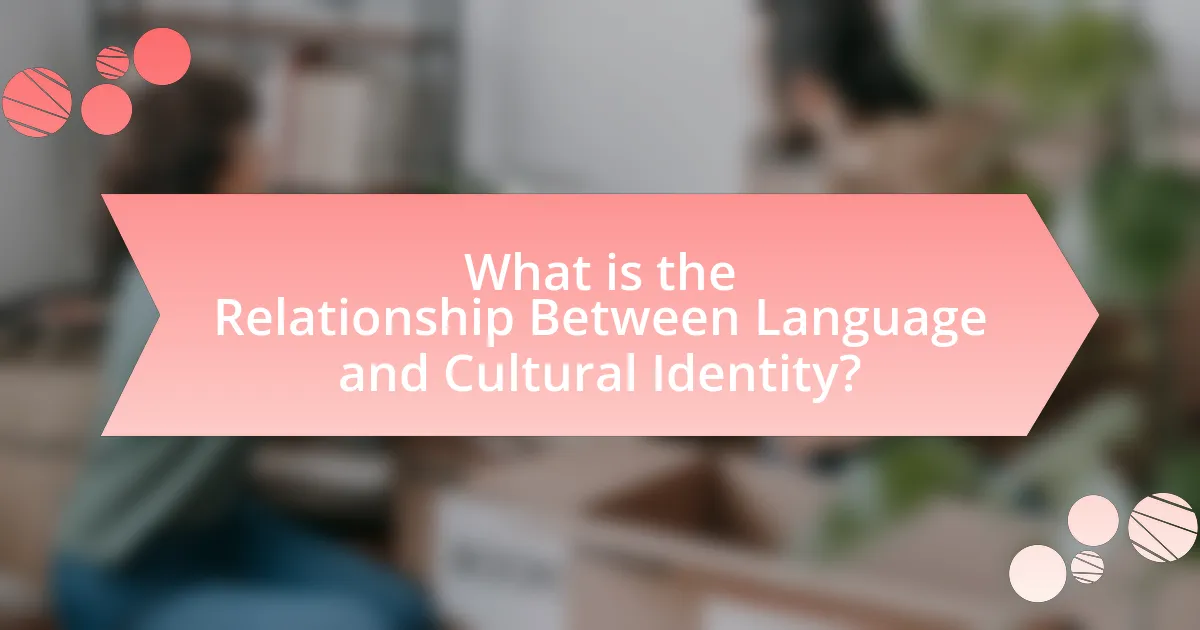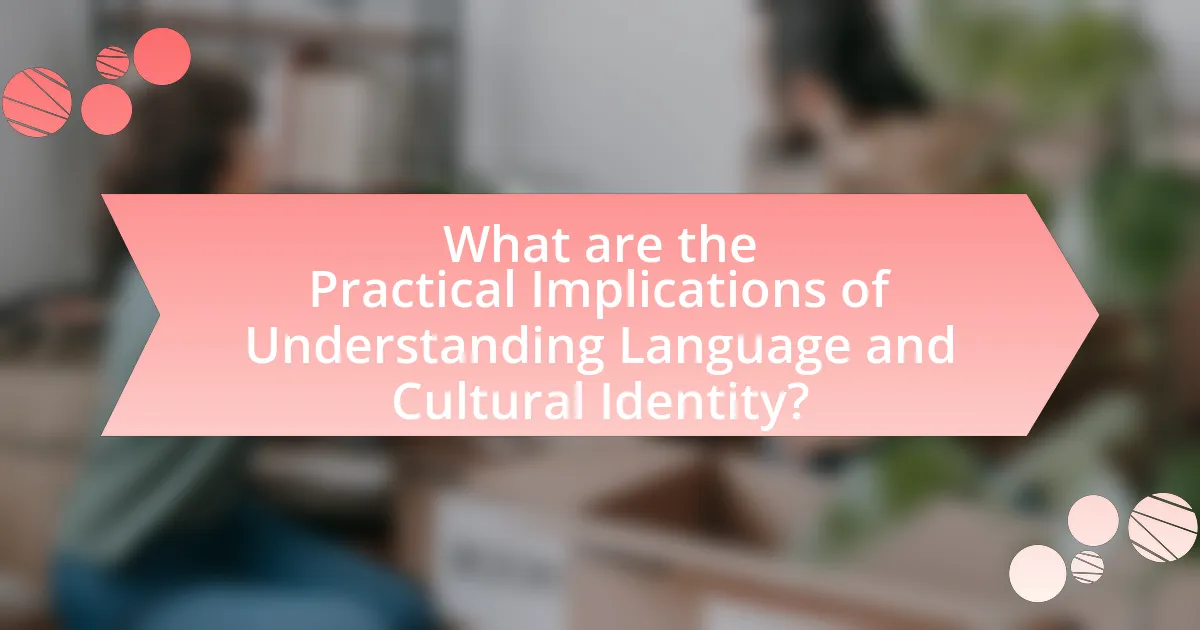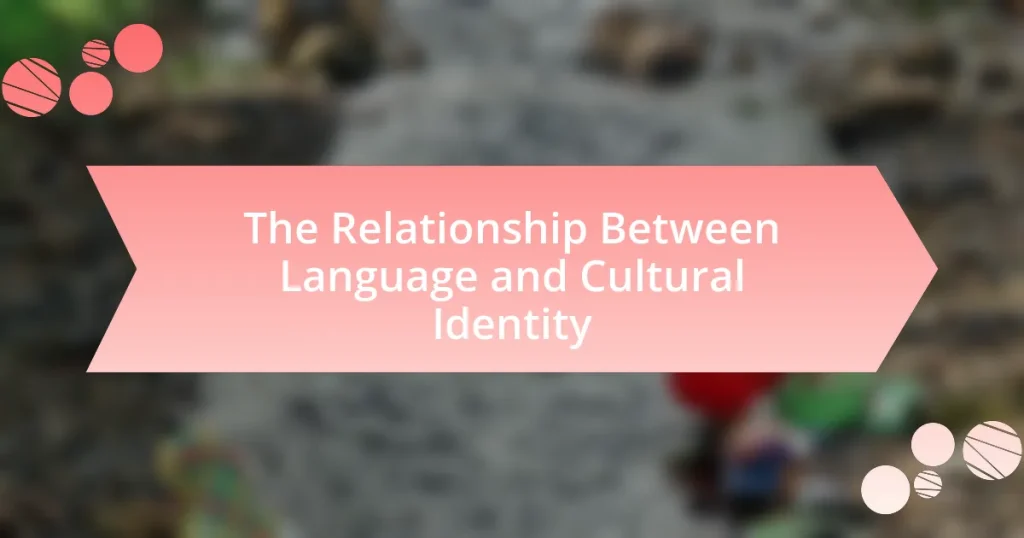The article explores the intricate relationship between language and cultural identity, highlighting how language serves as a fundamental component of cultural expression and social belonging. It examines how language shapes cultural identity through communication, vocabulary, dialects, and accents, reinforcing group cohesion and continuity. The discussion includes the implications of language loss on cultural identity, the effects of globalization, and the role of bilingualism in enhancing cultural understanding. Additionally, it addresses practical strategies for promoting linguistic diversity and cultural sensitivity in various contexts, emphasizing the importance of language preservation for maintaining cultural heritage.

What is the Relationship Between Language and Cultural Identity?
Language is a fundamental component of cultural identity, serving as a primary means through which individuals express their cultural heritage and social belonging. It shapes how people perceive the world and interact with others, reinforcing group identity and continuity. For instance, studies show that communities that maintain their native languages often experience stronger cultural cohesion and identity preservation, as seen in Indigenous groups worldwide who use language as a tool for cultural transmission and resistance against assimilation. Furthermore, linguistic diversity reflects cultural diversity, with each language encapsulating unique worldviews, traditions, and histories, thereby solidifying the connection between language and cultural identity.
How does language shape cultural identity?
Language shapes cultural identity by serving as a primary means of communication and expression within a community. It conveys shared values, beliefs, and traditions, which are essential components of cultural identity. For instance, linguistic features such as dialects and idioms reflect the unique experiences and history of a group, reinforcing a sense of belonging. Research indicates that language influences thought processes and social interactions, further solidifying cultural identity. A study by Sapir and Whorf highlights how language structures can affect perception and worldview, demonstrating that the language spoken can shape cultural understanding and identity formation.
What are the key elements of language that influence cultural identity?
The key elements of language that influence cultural identity include vocabulary, syntax, phonetics, and pragmatics. Vocabulary reflects cultural values and concepts unique to a community, while syntax shapes how ideas are expressed and understood within that culture. Phonetics can signify regional identity and social belonging, as accents and pronunciation vary across different groups. Pragmatics involves the context and social norms governing language use, which can reinforce cultural practices and relationships. For example, the use of honorifics in languages like Japanese illustrates respect and social hierarchy, directly linking language structure to cultural identity.
How do dialects and accents reflect cultural identity?
Dialects and accents reflect cultural identity by serving as markers of regional and social belonging. They convey information about a speaker’s geographical origin, social class, and community ties, which are integral to cultural identity. For instance, the distinct pronunciation and vocabulary of a Southern American English speaker can indicate their roots in the Southern United States, highlighting cultural heritage and local traditions. Research shows that language variation, including dialects and accents, is closely linked to group identity, as individuals often use these linguistic features to align themselves with specific cultural groups (Wells, 1982). This connection between language and identity is further evidenced by studies indicating that people often perceive accents as indicators of social status and cultural affiliation, reinforcing the idea that dialects and accents are not merely linguistic variations but also vital components of cultural identity.
Why is language considered a marker of cultural identity?
Language is considered a marker of cultural identity because it serves as a primary means of communication that reflects the values, beliefs, and traditions of a particular group. This connection is evident in how language encapsulates unique cultural expressions, idioms, and narratives that are specific to a community. For instance, the preservation of indigenous languages often correlates with the maintenance of cultural heritage, as seen in studies showing that language loss can lead to diminished cultural identity among indigenous populations. Furthermore, sociolinguistic research indicates that language can influence social cohesion and group identity, reinforcing the idea that shared language fosters a sense of belonging and cultural continuity.
What role does language play in community belonging?
Language serves as a fundamental tool for fostering community belonging by facilitating communication and shared understanding among members. It creates a sense of identity and belonging through the use of specific dialects, idioms, and expressions unique to a community. Research indicates that individuals who speak the same language often experience stronger social ties and a greater sense of belonging, as language reinforces cultural norms and values. For instance, a study published in the Journal of Language and Social Psychology found that shared language significantly enhances group cohesion and identity among community members. Thus, language not only enables interaction but also solidifies the emotional and cultural connections that define a community.
How does language preservation relate to cultural identity?
Language preservation is crucial to cultural identity because it serves as a primary means through which cultural values, traditions, and histories are transmitted. When a language is preserved, it maintains the unique worldview and social practices of its speakers, fostering a sense of belonging and continuity within a community. For instance, the loss of indigenous languages often correlates with the erosion of cultural practices and identities, as seen in studies showing that communities with active language revitalization efforts report stronger cultural ties and community cohesion. This demonstrates that language is not merely a communication tool but a vital component of cultural heritage and identity.
What are the implications of language loss on cultural identity?
Language loss significantly undermines cultural identity by eroding the unique expressions, traditions, and worldviews embedded within a language. When a language becomes extinct, the cultural narratives, values, and historical knowledge associated with that language are often lost, leading to a diminished sense of belonging and continuity among community members. For instance, UNESCO reports that over 40% of languages are endangered, highlighting the urgent need to preserve linguistic diversity to maintain cultural heritage. This loss can result in the disconnection of individuals from their ancestral roots, as language serves as a primary vehicle for cultural transmission and identity formation.
How does globalization affect language and cultural identity?
Globalization significantly influences language and cultural identity by promoting the dominance of major languages, such as English, while simultaneously threatening the survival of minority languages. This phenomenon occurs as global communication and trade increase, leading to a preference for widely spoken languages in education, media, and business. According to a UNESCO report, over 40% of the world’s languages are at risk of disappearing, which directly impacts cultural identity as language is a key component of cultural heritage. Furthermore, the blending of cultures through globalization can lead to hybrid identities, where individuals adopt elements from multiple cultures, potentially diluting traditional cultural practices.
What are the consequences of bilingualism on cultural identity?
Bilingualism significantly influences cultural identity by allowing individuals to navigate and integrate multiple cultural frameworks. This duality can lead to a more nuanced understanding of one’s own culture and the cultures of others, fostering greater empathy and adaptability. Research indicates that bilingual individuals often experience a richer cultural identity, as they can draw from diverse cultural practices, values, and perspectives. For instance, a study by Grosjean (2010) highlights that bilinguals often feel a sense of belonging to both cultures, which can enhance their social networks and cultural engagement. Thus, bilingualism not only shapes personal identity but also contributes to cultural diversity within communities.

How do Different Cultures Perceive the Relationship Between Language and Identity?
Different cultures perceive the relationship between language and identity as deeply interconnected, with language serving as a primary vehicle for expressing cultural identity. For instance, in many Indigenous cultures, language is not merely a means of communication but a repository of history, traditions, and values, reinforcing group identity and continuity. Research by the Linguistic Society of America highlights that language loss often correlates with cultural erosion, emphasizing the role of language in maintaining cultural heritage. In contrast, globalized cultures may view language as a tool for social mobility and integration, where proficiency in dominant languages can enhance individual identity within a broader societal context. This duality illustrates that while some cultures prioritize language as a cornerstone of identity, others may adapt their linguistic practices to navigate multicultural environments, reflecting diverse perceptions of the language-identity relationship.
What are the cultural variations in language use?
Cultural variations in language use refer to the differences in how language is employed across diverse cultural contexts. These variations manifest in aspects such as dialects, idioms, and communication styles, which are influenced by factors like geography, social norms, and historical experiences. For instance, in the United States, regional dialects such as Southern English and New York English exhibit distinct phonetic and lexical characteristics, reflecting the cultural identities of their speakers. Additionally, the use of honorifics in languages like Japanese illustrates how cultural values shape language, as these forms convey respect and social hierarchy. Such variations highlight the intricate relationship between language and cultural identity, demonstrating that language is not merely a communication tool but also a reflection of cultural heritage and social dynamics.
How do different cultures prioritize language in identity formation?
Different cultures prioritize language as a fundamental aspect of identity formation by using it as a primary means of expressing values, beliefs, and social connections. For instance, in many Indigenous cultures, language is not merely a communication tool but a vessel for cultural heritage, encapsulating traditions and worldviews that shape community identity. Research indicates that language preservation efforts, such as those seen in the revitalization of Native American languages, are crucial for maintaining cultural identity, as these languages often contain unique concepts and narratives that define the community’s existence. Furthermore, bilingualism in multicultural societies, like Canada, illustrates how individuals navigate multiple identities through language, reinforcing the idea that language is integral to personal and collective identity.
What examples illustrate the connection between language and identity in various cultures?
Language serves as a fundamental marker of identity across various cultures, exemplified by the use of indigenous languages in the Americas, which reflect cultural heritage and community belonging. For instance, the revitalization of the Māori language in New Zealand has strengthened cultural identity among the Māori people, as it embodies their history, traditions, and values. Similarly, the preservation of the Navajo language in the United States has been crucial for maintaining the Navajo identity, as it is intertwined with their spiritual beliefs and storytelling traditions. These examples illustrate that language is not merely a communication tool but a vital component of cultural identity, shaping how communities perceive themselves and their heritage.
How do cultural narratives influence language development?
Cultural narratives significantly influence language development by shaping the context in which language is learned and used. These narratives provide frameworks for understanding social norms, values, and experiences, which are essential for effective communication. For instance, children exposed to specific cultural stories and traditions acquire vocabulary and grammatical structures that reflect their cultural identity. Research by Barbara A. Fox in “Language and Culture” highlights that children learn language through the stories they hear, which embed cultural meanings and social practices, thereby reinforcing their linguistic skills within a cultural context. This interplay between narrative and language fosters not only vocabulary acquisition but also the development of pragmatic skills necessary for social interaction.
What stories or myths are conveyed through language in different cultures?
Language conveys numerous stories and myths that reflect the cultural identity of various societies. For instance, the Aboriginal Dreamtime stories in Australia articulate the creation of the world and the moral lessons tied to nature, emphasizing the connection between people and their environment. Similarly, the Norse myths, conveyed through Old Norse language, narrate tales of gods like Odin and Thor, illustrating themes of heroism and fate, which are integral to Scandinavian cultural identity. In addition, Native American languages often encapsulate creation myths and ancestral stories that convey respect for nature and community values, such as the Iroquois creation story, which highlights the importance of harmony with the earth. These examples demonstrate how language serves as a vessel for cultural narratives, preserving and transmitting the values, beliefs, and histories of different cultures.
How does language reflect historical experiences of a culture?
Language reflects the historical experiences of a culture by encapsulating its collective memories, values, and social dynamics. For instance, the presence of specific vocabulary related to agriculture in a language can indicate the importance of farming in that culture’s history, as seen in many indigenous languages that have numerous terms for local crops and farming techniques. Additionally, historical events such as colonization or migration often lead to the incorporation of foreign words and phrases, which can reveal the cultural exchanges and conflicts experienced by that society. For example, the influence of Spanish on the Tagalog language in the Philippines illustrates the impact of over three centuries of Spanish colonization, embedding elements of that historical experience into everyday communication. Thus, language serves as a living record of a culture’s past, reflecting its evolution and the significant events that have shaped its identity.

What are the Practical Implications of Understanding Language and Cultural Identity?
Understanding language and cultural identity has significant practical implications, particularly in areas such as communication, education, and social integration. Effective communication relies on a shared understanding of language, which is deeply intertwined with cultural identity; for instance, language shapes how individuals express their thoughts and emotions, influencing interpersonal relationships. In educational settings, recognizing the cultural backgrounds of students can enhance teaching methods and learning outcomes, as culturally responsive pedagogy has been shown to improve student engagement and achievement. Furthermore, in diverse societies, understanding language and cultural identity fosters social cohesion and reduces conflict, as it promotes empathy and respect among different cultural groups. Research indicates that communities with strong cultural identity and language preservation experience better social outcomes, including lower crime rates and higher levels of civic participation.
How can awareness of language and cultural identity improve communication?
Awareness of language and cultural identity can significantly improve communication by fostering mutual understanding and reducing misinterpretations. When individuals recognize the linguistic and cultural backgrounds of others, they are more likely to adapt their communication styles to be inclusive and respectful. Research indicates that effective communication is enhanced when speakers are aware of cultural nuances, as these can influence meanings and social cues. For instance, a study by Gudykunst and Kim (2003) highlights that intercultural communication competence, which includes awareness of language and cultural identity, leads to more effective interactions and relationship-building across diverse groups. This understanding helps to bridge gaps, facilitating clearer exchanges and promoting collaboration.
What strategies can be employed to respect linguistic diversity?
To respect linguistic diversity, strategies such as promoting multilingual education, supporting language preservation initiatives, and fostering inclusive communication practices can be employed. Multilingual education allows individuals to learn in their native languages while acquiring new languages, which has been shown to enhance cognitive development and cultural understanding. Supporting language preservation initiatives, like funding for endangered languages, helps maintain cultural heritage and identity, as evidenced by UNESCO’s efforts to document and revitalize languages at risk of extinction. Additionally, fostering inclusive communication practices, such as using interpreters and providing materials in multiple languages, ensures that diverse linguistic groups are represented and heard in various societal contexts.
How can educators incorporate language and cultural identity in teaching?
Educators can incorporate language and cultural identity in teaching by integrating culturally relevant materials and practices into the curriculum. This approach allows students to see their own cultural backgrounds reflected in the learning environment, which enhances engagement and understanding. For instance, using literature, history, and examples from diverse cultures can help students connect their language skills with their cultural identities. Research shows that culturally responsive teaching improves academic outcomes and fosters a sense of belonging among students, as highlighted in the work of (2010) in “Culturally Responsive Teaching: Theory, Research, and Practice.” By valuing and incorporating students’ linguistic and cultural backgrounds, educators create a more inclusive and effective learning experience.
What best practices can enhance cultural sensitivity in multilingual contexts?
Best practices that enhance cultural sensitivity in multilingual contexts include active listening, cultural awareness training, and inclusive communication strategies. Active listening fosters understanding by encouraging individuals to fully engage with speakers from diverse backgrounds, ensuring that nuances in language and culture are respected. Cultural awareness training equips individuals with knowledge about different cultural norms and values, which can prevent misunderstandings and promote respectful interactions. Inclusive communication strategies, such as using plain language and avoiding idiomatic expressions, help bridge language barriers and make information accessible to all participants. These practices are supported by research indicating that effective communication in multilingual settings significantly improves collaboration and reduces conflict (Gonzalez, 2020, Journal of Multilingual and Multicultural Development).
How can organizations promote inclusivity through language awareness?
Organizations can promote inclusivity through language awareness by implementing training programs that educate employees about the impact of language on cultural identity and interpersonal communication. These programs can help individuals recognize and challenge biases in language use, fostering an environment where diverse linguistic backgrounds are respected and valued. Research indicates that organizations that actively engage in language awareness initiatives see improved collaboration and reduced misunderstandings among team members, leading to a more inclusive workplace culture. For instance, a study by the American Psychological Association found that inclusive language practices enhance employee engagement and satisfaction, ultimately benefiting organizational performance.
What role does language training play in fostering cultural understanding?
Language training plays a crucial role in fostering cultural understanding by enabling individuals to communicate effectively within different cultural contexts. This training enhances awareness of cultural nuances, idiomatic expressions, and social norms that are embedded in language. For instance, studies have shown that learners who engage in immersive language training often develop greater empathy and appreciation for the perspectives of speakers from different cultures, as evidenced by research conducted by the American Council on the Teaching of Foreign Languages, which highlights that language learners exhibit improved intercultural competence. Thus, language training not only facilitates communication but also deepens cultural connections and understanding.
